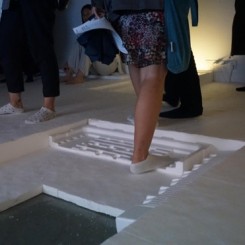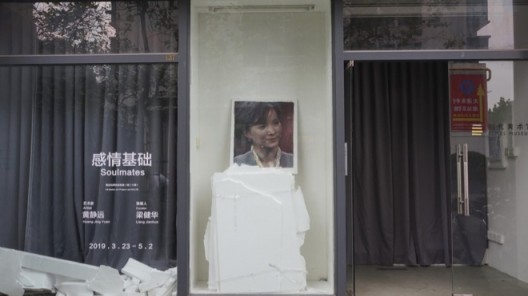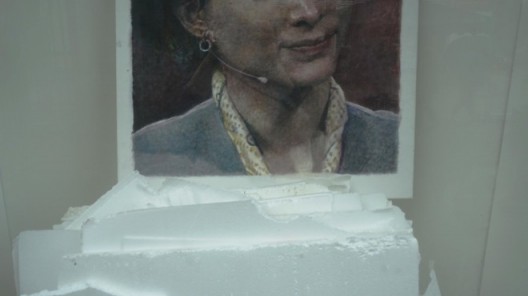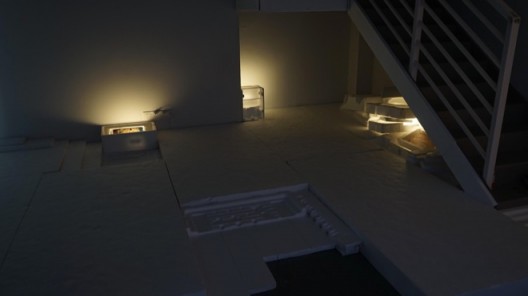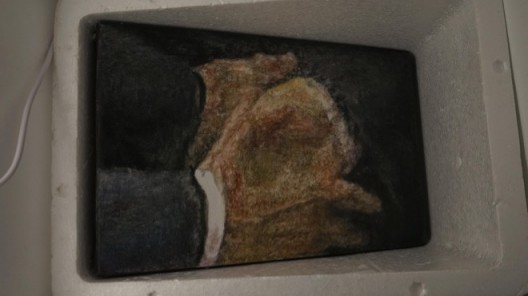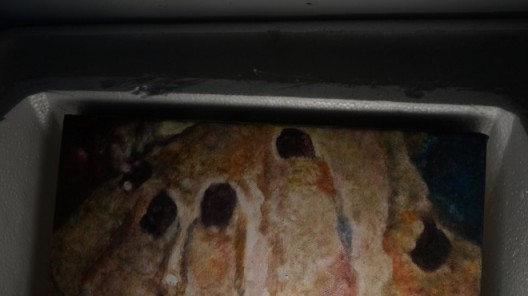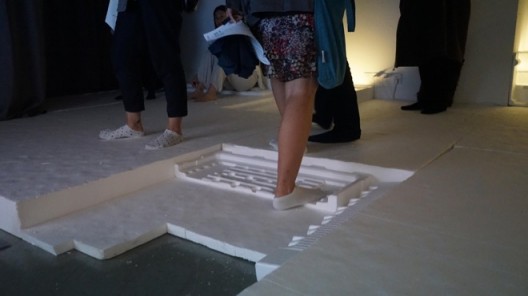By Yisi Li
When I think of JY, I always see her as a wicked and reserved commentator. She will secretly crack a joke of history just to make her argument sensible to the minds of insiders and outsiders. She can make a dull, logical elaboration of a system at once intimate, intriguing, and with a taste of bitterness. She walks comfortably in and out of different communities, leaving everyone some food for thoughts, and the warmness of a diligent, modest artist.
As the result of her 2017 residency at HB Station(Guangzhou), JY transformed the orderly-looking HB station office into a mini foam-maze with disposal foam boards collected from nearby neighbourhoods. Although these boards are cut into similar sizes, patterns vary. Deprived of the context their raison d’etre are granted, I find it difficult to decipher what these patterns tell. The setting evokes a sense of Whiteread’s installation: it feels intimate, yet detached; it touches you gently, yet a sense of cruelty lingers in your mind. A handful of paintings in JY’s typical realism style scatter around the space, each hidden in a small foam box as if the bulb inside that lits up each box is its sole spectator. Rest assured, there are indeed two paintings hung on walls. They are portraits of two female television stars. The one affixed to the wall furthest to the entrance is Ye Qian Wen, a 90s Hongkongnese popular singer, while the other portrait of Dong Qing—a CCTV television host familiar to every Chinese household, is hung next to the entrance.
Feeling fuzzy and warm in this dimly lit space, I naturally seated myself. My attention is soon directed to the video installation occupying most of the space—a 17 minutes long double-screen video work. Fragments of artists interviews, television dramas, CCTV live shows and academic forums form an atlas, ambitiously attempting to unfold the realities of the present day Chinese art world.
The video seems to be a harsh critique to the art world’s bipolar nature. It does not matter if you fail to drop names of supposedly-familiar artworld faces in the video or not. The persisting boundary between canonistic arts and Outsider art is omnipotently manifested through the cinematic language itself. The arrangement of the dual screen put down JY’s argument in an almost unmistakable way.
“What we are searching for is the truth.”
The comment is followed by a deliberate moment of silence that was allocated to the professionals at an academic forum—a moment to carefully digest the statement. Lenses on both screens abruptly switch focus—from the panoramic view of the forum to the close-up of two respected critics, capturing the immense elegance and ease of them in handling and sipping the Gong-Fu Cha (Chinese traditional tea making).
“When no one can save you, it is only you that can save yourself.”
Upon carefully inspecting each painting laid in a row at a living room, the right screen is cut to the close-up side face of our heroine Xiao Qin, with her gaze extending from what we could see in the screen to an imperceptible distance. Seated, facing against the left screen —where a live recording of the same academic forum is played, she gave us her final words.
“I would say, generations of our artists aspire to portray the Zeitgeist.”
Almost like schizophrenia, the left screen uses the classic short-reverse-shot to unfold a conversation between a CCTV host and a well-known art professional. Both eagerly to reach a consensus, their confidence of defining history naturally reveals itself. Yet, what appears on the right screen—the fleeting image of an artist whose voice is muted—put an unease to the portrait of this harmony.
In the words of Jing Yuan herself, her methodology is to challenge an existing system by offering her own picture of it. It isn’t a rare practice, if we familiarise ourselves with artists such as Rikrit Tiravanija, who questions out loud the relation between arts and life with his caption “Do We Dream Under the Same Sky” screen-printed on top of collages of newspapers. To a more focused scope on the system of arts itself, we have the carefully scripted works of Andrea Fraser (A Gallery Talk 1989), Asli Cavusoglu ( Murder in Three Acts 2012), or Zhou Tie Hai. Being said, in comparison to her predecessors, JY purposely steps back from being an “artist as a creator” to “artist as an observer,” deploying a meticulous and reserved manner to scrutinise the system. Slicing the system apart recurrently from the same angle—the unspoken barrier and compartmentalisation of the art world, her means of narration invites an intertextual and non-linear way of reading, in which a sense of anxiety—from the incapability of defining and attributing causality–emerged.
This sense of anxiety is manifested through interviewees and audiences of the video. For instance, when the prosthetics are gifted to Lele as the moment of consummating the heart-felt compassion, an almost unconscious comment that “Let’s see what LELE likes when he is standing” uttered from the TV commentator captures my attention. Juxtaposed it with a muted interview recording of an artist on the right screen, the fuzziness of shared sympathy transmutes into an uneasiness of those unspeakable thoughts. Meanwhile, the nature of Huangbian Station—an artistic community affiliated with Times Museum yet remains independent in its program development—might be the physical platform to battle against the anxiety. In the same way that the common thread of the five artists in JY’s another video work “Solutions” is their shared identity as a mother and the daily happenings, this exhibition attempts to construct a malleable space where everyday life and professional practice could find ease at each other.
In this way, the sense of unease becomes the emotional foundation, allowing the action of “discussing arts” to unfold realities from various systems—CCTV charity live show, lives and works of the outsiders and the insiders of the artworld to us. With her decentralised and comparative approach, the artist suggests a consensus that could be reached not by any parameter specific to the artworld itself, such as the narration of global art history, or the logic of cultural production in the late-capitalism age. Rather, something more intrinsic to us as human being, hidden deep inside our subconsciousness is what JY aspires to evoke.
All photos: the artist
Huang Jing Yuan: Soulmates
Opening: 2019.3.23 (Saturday) 3:00pm
Duration: From Wednesday to Sunday: 2:30pm – 6:30pm(2019.3.23-2019.5.2)
Address: NO.338, Xiangrong Street. Huangbianbei Road, Baiyun Avenue, Guangzhou
